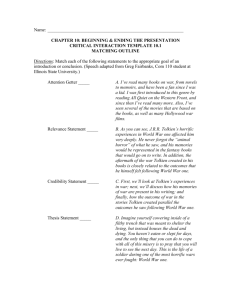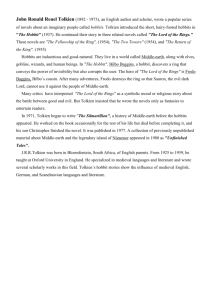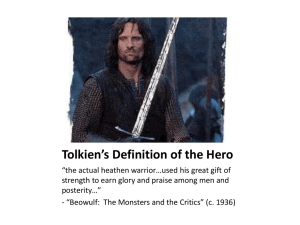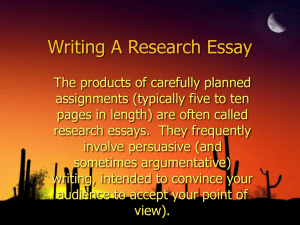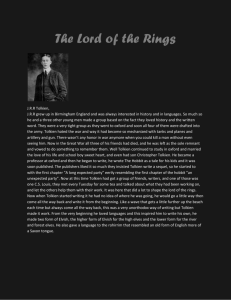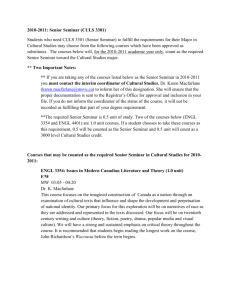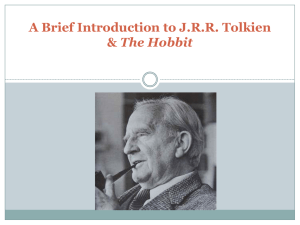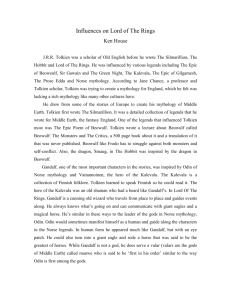Exploring Middle-Earth: A Guide to Tolkien and The Lord of the Rings
advertisement
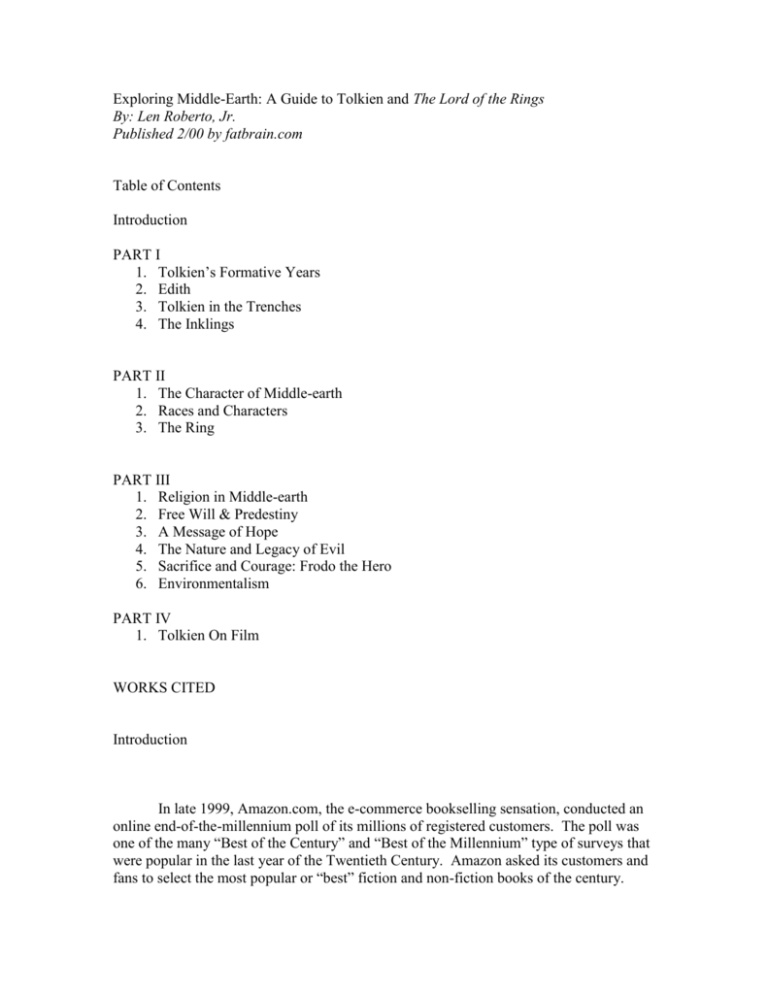
Exploring Middle-Earth: A Guide to Tolkien and The Lord of the Rings By: Len Roberto, Jr. Published 2/00 by fatbrain.com Table of Contents Introduction PART I 1. Tolkien’s Formative Years 2. Edith 3. Tolkien in the Trenches 4. The Inklings PART II 1. The Character of Middle-earth 2. Races and Characters 3. The Ring PART III 1. Religion in Middle-earth 2. Free Will & Predestiny 3. A Message of Hope 4. The Nature and Legacy of Evil 5. Sacrifice and Courage: Frodo the Hero 6. Environmentalism PART IV 1. Tolkien On Film WORKS CITED Introduction In late 1999, Amazon.com, the e-commerce bookselling sensation, conducted an online end-of-the-millennium poll of its millions of registered customers. The poll was one of the many “Best of the Century” and “Best of the Millennium” type of surveys that were popular in the last year of the Twentieth Century. Amazon asked its customers and fans to select the most popular or “best” fiction and non-fiction books of the century. The winner by far and away was J.R.R. Tolkien’s half million words long three book epic, The Lord of the Rings. In true anti-Tolkien fashion, many scholars and literary critics gagged at the thought, as scores of critics have done since the last book of the trilogy was published in the mid-1950’s. Their scornful rantings against Tolkien’s much-loved epic fortunately could not tarnish what millions of readers have known for much of this century. Tolkien struck a chord in the hearts of readers the world over, and they were not afraid of the critics’ ramblings when voting. They had once again shouted their feelings that Tolkien, the Oxford don and scholar of word origins was deserving of the highest praise. The book is a worldwide bestseller. “The grand total is thus well on its way to 100 million. Tolkien’s books have been translated into more than thirty languages”1 and remain on every bookstore’s core list of titles that are always replenished on their shelves. Scores of books have been written about Tolkien and his world, Middle-earth, a fantastic yet familiar creation. Critics and fans have analyzed the author, his influences, and his life in newsletters and books for many years. Tolkien calendars have been produced each year since the mid-1970’s, there are role-playing games based on his characters and settings, action figures and pewter scultpures, and hundreds of artists that create paintings based on Middle-earth. There have been Middle-earth diaries, cookbooks, maps, scrapbooks, and books about the languages of Tolkien’s characters. Type in the word “Tolkien” on a web search engine and you will be inundated with thousands of websites from all over the globe that seek to praise, explain, debate, educate, merchandise, and idolize the creator of an imaginary world that millions have visited time and time again. These sites are not managed by literary critics but by fans of the late professor’s writings. “In other words, we are talking about a massively popular and successful publishing phenomenon.”2 The risk that Rayner and Unwin took, Tolkien’s initial publishers, proved to be one of the most beneficial publishing decisions of the century. Clearly there must be something to Tolkien’s creations from his hobbits and elves to magic rings and wizards that inspires such devotion to this day. This book will not seek to explain the reasons why so many critics have heaped scorn on Tolkien, his works and his readers. Nor does it seek to explain the intricacies and techniques the author used to construct his tale. There have been many influential and respected writers and critics who have recognized the appeal of Tolkien through the years and this book also does not have as its goal to defend his work. In turn, this book is aimed at the Middle-earth outsider; the novice who has always heard of or known friends that praise the work but have never summoned up the courage to wade through an extremely long set of books about some far off imaginary land. A guide of sorts is needed for these potential readers, something that might sway them to pick up the first book of the trilogy and see what all the hype is about. Offering a glimpse into the wonder of Middle-earth is the intention. The level of awareness of The Lord of the Rings will most certainly increase throughout the year 2000 and beyond due to the steadily building hype surrounding the much anticipated film presentation. New Line Cinema, with director Peter Jackson at the helm, have committed a $190 million budget to producing the very first full length feature film series of The Lord of the Rings. In the past, the only visual productions that fans have suffered through were ill conceived animated films. It was believed that the technology did not exist to do the story proper justice. That has now changed with the increased power of computer graphics programs. The first of three films is set for release in the summer of 2001 with parts two and three coming out in winter 2001 and summer 2002. Filming for these films began in October 1999 in New Zealand. Using live characters and an amazing portfolio of special effects and computer graphics, these releases promise to rival the anticipation and hype of Star Wars: Episode I. The cast includes many well known actors such as Liv Tyler, Ian McCellen, Ethan Hawke, Uma Thurman, Christopher Lee, and others. There are numerous websites that have daily updates relating to film news as well as spy photographs of the sets and rumors to discuss. Debate rages in chat rooms and bulletin boards on plot structure, characterization, and tone of the upcoming films. Contracts are set for action figures and countless other movie tie-ins. Trailers for these films will excite life-long fans, mildly interest some movie-goers, and tempt many others that have never read Tolkien’s masterwork. This book speaks to the latter group. There have been countless books written about Tolkien’s life, his themes and subplots, his sources, and the meanings behind the story. This book does not presume to rehash those discussions, argue a point made in past studies, or take issue with another author’s opinions or studies. There is much to be learned from their efforts but this study is merely a presentation of Tolkien, the world he opened for all of us to explore, and a discussion of some powerful sub-plots and themes to think about when viewing the films and hopefully, reading the epic. Wrapping your arms around a story that is nearly half million words long can be a daunting prospect for some, especially those that don’t consider themselves avid readers. Perhaps it helps to be aware at least briefly about the author of this epic fantasy to get a glimpse of childhood years and his professional career. It would also certainly benefit a potential reader and movie-goer to learn about the setting for this story and the characters they can expect to meet along the way. So many people when asked if they “know” Tolkien have certainly heard of the name but have no clear notion of what his books are about. This unfortunately can shut down the impulse to pursue the matter especially when they hear of its length. If they are also told that it concerns elves, dwarves and wizards it can stifle the desire further if no other explanations are provided. Finally, it may spark the interest of others to learn something about what the underlying messages or themes of the work are before they commit to reading it. A basis for debate and discussion in their own minds can be enough to go forward. This book seeks to delve into these three areas; the author’s life experiences, a look at the world he created, and a discussion of the foundation of the work. Traditional literary criticism will not be found here but rather an explanation of some obvious references and perhaps some wanderings in modern interpretation to stir the mix. For those ambitious souls who venture out to the movies without having read the trilogy beforehand, this book may in turn provide a window into further study of Tolkien. It may also be of assistance to those who have read the story and now seek to learn more about what they have experienced. Before wading in to the scores of books published on Tolkien through the years, this volume can be a “primer” and provide a foundation and spark for investigating specific aspects of Middle-earth. A reader however does not need to buy into Tolkien’s messages and complex theme structure. “Some may enjoy the message without understanding, as some enjoy Beethoven for the fine noise.”3 Tolkien can be enjoyed on many levels and it is up to readers to invest as much thought and insight as they wish. Regardless of what some critics may have said through the years, a journey to Middle-earth is a rewarding reading experience that many people go back to year after year. Tolkien was a storyteller in the grandest traditions of the past. As you will see, The Lord of the Rings is a journey of discovery not only for many of the characters but for readers as well. So make ready your mental backpacks, sit by a warm fire at night with a good ale and pipe to smoke as Tolkien would have enjoyed, and begin your journey to Middle-earth. Chapter 3: The Ring Unlike most stories with a quest theme where the goal is to retrieve something of vital importance, Tolkien’s version of the quest theme in The Lord of the Rings has the goal of destroying something of interminable evil. The Ring is the source of ultimate power in Middle-earth but it was crafted by Sauron long ago and cannot ever be used for any good purposes despite the noble intentions of the wearer. The craft of ring making in Middle-earth goes back thousands of years. Originally it was the elves and dwarves who mastered the art and imbued their rings with power to create and build fantastic things when wielded by the wise. Sauron, who was learned in many crafts, became obsessed with the power within these “magic” rings and turned his attention to making his own. Eventually he succeeded, and as his power grew his ringmaking skill did as well. He gave some of his rings to the rulers of men as gifts that would seduce and ensnare them to his will. By doing this, he gained nine kings of men long ago and by their decision to seek wealth and power, they became Sauron’s most terrible servants. They became known as the Ringwraiths, the Nazgul, and are the Black Riders that pursue the hobbits out of the Shire. Finally, Sauron invested a considerable portion of his power and energy into the One Ruling Ring which on his hand would have power over all the rings made by others and whatever they created as well. The whole history of the Ring and how it came to be around Frodo’s neck is told in the first book of Tolkien’s trilogy. The second chapter of The Fellowship of the Ring, (the first volume in the trilogy,) is entitled “The Shadow of the Past,” and is Gandalf’s history lesson to Frodo explaining the Ring’s past. At some points in its history, it seems like the Ring has a mind of its own but we soon learn that in some way it was in fact trying to influence events and find its way back to its master’s hand. It has many mysterious powers. The Ring was lost by Sauron thousands of years ago in battle and was found by Isildur, a forefather of Aragorn. Isildur’s refusal to destroy it when he had the chance cost him his life as it slipped off his finger in a battle with Sauron’s orcs. There it would lay at the bottom of a river until Deagol found it many years later, once again mysteriously making its presence known. But what of the power of the Ring as it relates to hobbits, men, elves, and dwarves? Why did Isildur not destroy it long ago when he had a chance and why does Gollum search to the ends of the earth to regain it? The Ring’s power and effect is related to the inner strengths of its wearer. To a simple hobbit like Bilbo, who stumbles upon the Ring in The Hobbit, it makes him invisible and to him that appears to be its only attribute. Also, because Bilbo and later Frodo acquire the Ring with pity and mercy and do not resort to violence to gain possession, the Ring exerts less negative forces upon them. “Gandalf explains that because Bilbo gained the Ring with pity and mercy (rather than the murder with which Gollum took it) the Ring’s evil only faintly corrupted him, while the good effects of his action made it possible for Frodo to inherit the Ring and begin his own quest for its destruction.”1 What has happened to Gollum and to a lesser extent Bilbo and Frodo, is that the Ring has exerted its evil power over them. It merely extends the existence of its keeper rather than give new life. Possessors of the Ring do not die but merely continue to exist and they eventually become shadows of their former selves. The Ring fosters intense feelings of jealousy and greed so that the owner is fiercely protective and cannot bear to be away from it or dream of it on anyone else’s hand. The Ring is hated yet desired at the same time by its owner. It simply enslaves and corrupts its owner over time. Tolkien equates the lust and desire for such power with the truest form of evil in Middle-earth. “The damned and ultimate losers, so far, are those who seek, grasp and use Power for their own ends against the Order of Things.”2 Every major character is at one point or another tempted to possess the Ring. Gandalf, Aragorn, Galadriel, and Boromir are either offered the Ring freely by Frodo or given a simple opportunity to grasp it with little resistance. Those who pass the test realize that the Ring cannot be used for anything but evil, that it will corrupt and enslave the wearer no matter the good intentions in the beginning. Those who fail, such as Boromir, fall prey to the overwhelming desire to seize the ultimate power for themselves. “Hence also another moral strand, not yet dwelt upon, running from end to end of the epic—the need for everyone in the West to resist the evil inherent in his own nature.”3 As noted above, the way that possession of the Ring is acquired dictates the effect it will have on the possessor. A related comparison in modern terms is the Star Wars theme of the Dark Side of the Force; that anger and hate leads down an evil path. “Anyone who uses coercion in even the best of causes is using an evil means to a good end and thereby corrupting the end—and himself.”4 This notion also relates to another of Tolkien’s brilliant subthemes; the irony that evil deeds usually result in good endings. There are numerous examples of this throughout the story. Boromir’s attempt to take the Ring by force causes Frodo and Sam to depart alone and eventually allows them to progress silently without drawing attention to themselves. Saruman’s directive to his minions to capture any hobbits they can find, who he believes will have the Ring or news of its whereabouts, results in his orcs speedily carrying Merry and Pippin into Treebeard’s lap where they can arouse the Ents to battle. Saruman’s nasty servant Grima Wormtongue, in another act of hatred, throws an object at Gandalf during a discussion from the Tower of Orthanc. His goal was to strike Gandalf out of malice and spite. This object turns out to be an ancient and powerful talisman called the Palantir that Aragorn then uses against Sauron. It is clearly stated by Theoden, Gandalf and others at different moments in the story, aptly summarized in the simple statement: ‘Strange are the turns of fortune! Often does hatred hurt itself!’ (The Two Towers, pg 243.) The most memorable example of this is of course Gollum’s final curtain call at the foot of Mount Doom. Frodo and Sam, having finally made it to the Fires where the Ring can be destroyed, are saved by the malice and desire of Gollum. Frodo, overcome finally with the weight of his burden, cannot at the last moment destroy the Ring as it has momentarily consumed his will. It is up to Gollum’s evil action to force the issue and save the quest. Evil, in its moment of seeming triumph, fails in spite of itself. I won’t reveal exactly how Gollum accomplishes his final act—that is a climax worth experiencing firsthand! We have examined the history of the Ring, its importance and relevance to Tolkien’s epic, and the effects of desiring and keeping it. But what did Tolkien mean to symbolize in this creation? There have been many theories and explanations put forth attempting to answer this question. An obvious possibility that many have explored is that the Ring is a symbol for nuclear arms or more simply stated, “The Bomb.”. This is understandable but is too easily explained. Tolkien was far too savvy a writer for such simple comparisons. Written and published in the tense opening years of the Cold War, when the nuclear arms race was accelerating and Mutual Assured Destruction was presented as a viable strategy, the Ring can understandably be viewed in this light. There is more to it than that alone however. “The Ring does not equal the Bomb, but is rather a symbol for the entire complex fact that twentieth-century man has, like Frodo, suddenly found himself, without wanting it, without even guessing it would find a way into his pocket, in possession of a power over nature so immense even the desire to use it will inevitably corrupt his soul.”5 Expanding on this point, the Ring is a symbol for the temptation of any and all kinds of power. The old saying that power corrupts and absolute power corrupts absolutely is appropriate to understanding more of what Tolkien was trying to convey. The powerhungry that seek to gain power over others or nature are doomed. It is the humble and simple, like the hobbits, that are ultimately saved. PART IV Chapter 1: Tolkien On Film On August 24, 1999, New Line Cinema publicly announced what previously had only been excited rumors. They were going to fund and produce three full length, live action film installments of Tolkien’s The Lord of the Rings to be released in six month intervals beginning in the winter of 2000. Peter Jackson, a New Zealander and relatively unknown entity in the US, was revealed as the director and a budget of approximately $180 million dollars to make the films was announced. Filming was to begin in October 1999 in New Zealand where the currency exchange would make New Line’s budget equal about $350 million in actual dollars. Soon after this, sale of Tolkien’s books showed a significant increase and fan speculation began to gear up for the anticipated releases. The majority of Tolkien fans took a stance of wariness about the films and with good reason. Tolkien’s previous representations on screen were major disappointments to say the least. A much heralded film adaptation of The Lord of the Rings was released in 1979 to a lukewarm reception. This was an animated film that also used some scenes with live actors that were made to appear as animation. Due to budget restrictions, license disagreements, and other drawbacks, the film was not the complete story and it ended somewhere in the middle of the second volume. Adding to this disappointment, according to Tolkien fans, the film’s animated representations of most characters was comical in one sense and downright blasphemous in some cases. Most readers were expecting a different style and treatment and reacted against the childish and comic attempts to present characters truthfully. The film did not do well in theaters despite a fair amount of awareness. So it was with guarded optimism that Tolkien fans accepted New Line’s announcement. Gradually as more information leaked out to hungry fans, it became clear that this production would go a long way to making Tolkien fans happy. On June 9, New Line launched an official website for the movie with nothing more than tantalizing images of pre-production scenes. These images were enough to convince the most skeptical of fans that there was reason to hope this time around. Even before the official word from New Line Cinema, there were anxious fan websites springing up that provided daily news updates of any news regarding the films. By late 1999, there were scores of Tolkien sites with regularly updated sections with cast news, set rumors, and interviews with extras to feed the fires of anticipation. Some of the more popular sites provide regular reports from “spies” in New Zealand who send in photographs and descriptions of possible scenes, costumes and actor sightings. Some of these sites receive more than 5,000 visitors a day, starved for any news to appease their Tolkien mania. In fact, all of the information used to write this chapter was taken from various Tolkien websites! A considerable amount of attention is being paid to how the story will be presented. It is clear that there is a protective cult of awareness surrounding the sanctity of Tolkien’s vision and many fans fear that portions of the story or characters will be sacrificed or changed to make it more “Hollywood.” Peter Jackson, the director but more importantly fan of Tolkien, was wise enough to realize this growing concern even before filming began. Rumors sprang up about characters changing and scenes being slashed. He posted on a message board on the Ain’t-It-Cool-News website an offer for fans to write in with their questions and he would select the most representative ones to answer. He received over 14,000 questions and chose to answer the 20 most popular. This was a great way to stoke the interest of fans and at the same time cool the incorrect rumors. His answers were a revelation for fans. Jackson revealed that he would be sticking as closely as possible to Tolkien’s vision and his themes of sacrifice, friendship, and the nature versus machine overtones that we have discussed here. He also said that no characters would be combined and no new characters would be added. He did hint that some things would have to be altered due to time and plot constraints but that nothing would be altered that would harm the central action of the story. Tolkien fans breathed a sigh of relief. Another exciting piece of news that he revealed was the use of top of the line special effects wizardry. His special effects company named WETA has developed special software called MASSIVE that will be used in some of the immense battle scenes. The battles of the War of the Ring should be spectacular to watch on screen with hundreds of thousands of orcs and men writhing across the fields. The films are also being shot in Super 35 which makes a film ratio of 2.35 to 1. This results in a wide sweeping angle reminiscent of great movie epics of the past. All of the information that has been released so far has only served to heighten awareness and calm most fears. There are still a few aspects of the films that have raised the ire of some hardline fans who have started petitions to keep the films exactly as written. One of the storylines that appears to be altered in the script is the romance between Aragorn and Arwen. In order to strengthen the very strong Hollywood theme of romance, Arwen will appear in all three movies in a much more prominent role than she actually has in the trilogy. Perhaps the reasons for this lie in attracting more female moviegoers to a “love story.” In another move, Sauron will have a tangible presence in the films as opposed to the nebulous and mysterious aura he maintains in the book. This is of course to isolate and emphasize the “villain” in the movie and give people a character they can easily despise. Another wonderful yet nearly useless Tolkien character, Tom Bombadil, will be eliminated. Tom is a merry spirit of the forest who saves the hobbits on their way to Rivendell. With really no role in driving the plot, it was decided to eliminate his character. All of these changes can be accepted by the average fan and the Tolkien scholar when considering the overall scope of the films. The petitioners and complainers have to look at the films as an interpretation and not an exact faultless copy of the books. These people forget that every film is a product in some way, large or small, of the director’s interpretation of the work. We should be satisfied that Jackson has professed his desire to keep the films faithful to Tolkien and leave it at that. The other major area of fan discussion and website updates was the slowly constructed list of cast members. On July 8, Elijah Wood was announced to play the role of Frodo. This started a flood of fan emails discussing the choice and the rumors of other actors. It was already known that there would be some well known actors and actresses playing alongside some unknowns but gradually the cast was finalized and most fans were pleased with the prospects. Liv Tyler will play Arwen, Aragorn’s Elven maiden, Sean Bean will play Boromir, Sir Ian Holm will take the part of Bilbo, Donald Sutherland will play Denethor, Ethan Hawke is cast as Faramir, Cate Blanchett will play Galadriel, Sir Ian McKellen will play Gandalf, Christopher Lee will use his talents to play Saruman, and the list goes on. Other characters such as Gollum are rumored to be exclusively generated by computer graphics. Rumors still persist that other famous actors such as Sean Connery will be in the movies but there is no confirmation of that. A crew of over 300 is also involved for makeup and set preparation duties as well as software and graphic artists for the special effects. All in all, we can continue to be excited about the films for all of the above mentioned reasons. As of February 2000, awareness of these films is steadily reaching mainstream America. There have been numerous magazine articles with cast members who speak of the films in glowing terms. Other articles provide spy photos and speculation. There has even been brief mentions on CNN of the upcoming movies. The hype for the first film’s release, still not definitively set for the Spring of 2001, is often compared to the release of Star Wars Episode I: The Phantom Menace. The release of this film was a circus of media hype and intense speculation. Lines assembled outside of toy stores to gobble up the new Star Wars action figures and spaceships. There were lines a week before the film’s release date simply to buy tickets and movie theaters showed the film day and night to fulfill the need for thousands of fans. In an article in February, it was announced that some fans were organizing camp outs at ticket booths for The Lord of the Rings in the same manner as was done for Star Wars. Whether to get in the spirit of Tolkien or to raise money for charity, camping out for tickets weeks before the release of these movies emphasizes the extraordinary anticipation for The Lord of the Rings. Reaching the level of hype generated by Star Wars is debatable. Almost no one doubts that the New Line production will be the most eagerly awaited film of 2001 and all signs indicate a very healthy box office draw. The hard core Tolkien fans are most assuredly planning to see the films. It is those who have not read Tolkien that New Line seeks to attract and it will be interesting to see how they market and promote the movie to the uninitiated. After nearly a half-century in print, The Lord of the Rings has had an immense impact on popular literature and culture. He inspired countless authors to write in the format of epic fantasy and believe that it could be a successful and meaningful genre as well. Terry Brooks’ Shannara series, Stephen Donaldson’s Unbeliever series, and David Eddings’ Wheel of Time series are just a few examples that bear Tolkien’s fingerprints in some way. This book has tried to provide a general overview of Tolkien the man and Tolkien as the creator. Hopefully, it has given the reader enough incentive to pick up Tolkien’s masterwork before or after viewing the film versions. It will be an exploration of incredible scope and a journey of discovery that will not soon be forgotten. WORKS CITED Introduction 1 Curry, Patrick. Defending Middle-earth: Tolkien: Myth and Modernity. New York: St. Martin’s Press, 1997. pg. 12. 2 Ibid., pg. 13. 3 Ready, William. Understanding Tolkien. New York: Paperback Library, 1969. pg. 33. PART I Chapter 1 1 Carpenter, Humphrey. Tolkien. Boston: Houghton Mifflin Company, 1977. pg. 20. 2 Pearce, Joseph. Tolkien: Man and Myth. San Francisco: Ignatius Press, 1998. pg. 18. 3 Ibid., pg. 23. 4 Carpenter, Humphrey. Tolkien. Boston: Houghton Mifflin Company, 1977. pg. 129. 5 Curry, Patrick. Defending Middle-earth: Tolkien: Myth and Modernity. New York: St. Martin’s Press, 1997. pg. 109. 6 Pearce, Joseph. Tolkien: Man and Myth. San Francisco: Ignatius Press, 1998. pg. 21. Chapter 2 Chapter 3 1 Ready, William. Understanding Tolkien. New York: Paperback Library, 1969. pg. 12. 2 3 Pearce, Joseph. Tolkien: Man and Myth. San Francisco: Ignatius Press, 1998. pg. 39. Curry, Patrick. Defending Middle-earth: Tolkien: Myth and Modernity. New York: St. Martin’s Press, 1997. pg. 55. 4 Pearce, Joseph. Tolkien: Man and Myth. San Francisco: Ignatius Press, 1998. pg. 112. 5 Ready, William. Understanding Tolkien. New York: Paperback Library, 1969. pg. 12. PART II Chapter 1 1 Kocher, Paul H. Master of Middle-earth: The Fiction of J.R.R. Tolkien. Boston: Houghton Mifflin Company, 1972. pg. 8. 2 Curry, Patrick. Defending Middle-earth: Tolkien: Myth and Modernity. New York: St. Martin’s Press, 1997. pg. 27. 3 Ibid., pg. 61. 4 Ibid., pg. 61. 5 Ibid., pg. 27. 6 Ibid., pg. 63 7 Carter, Lin. Tolkien: A Look Behind The Lord of the Rings. New York: Ballantine Books, 1969. pg. 93. 8 Kocher, Paul H. Master of Middle-earth: The Fiction of J.R.R. Tolkien. Boston: Houghton Mifflin Company, 1972. pg. 9. 9 Pearce, Joseph. Tolkien: Man and Myth. San Francisco: Ignatius Press, 1998. pg. 99. 10 Curry, Patrick. Defending Middle-earth: Tolkien: Myth and Modernity. New York: St. Martin’s Press, 1997. pg. 24. Chapter 2 1 Carter, Lin. Tolkien: A Look Behind The Lord of the Rings. New York: Ballantine Books, 1969. pg. 192. 2 Ready, William. Understanding Tolkien. New York: Paperback Library, 1969. pg. 45. Chapter 3 1 Helms, Randel. Tolkien’s World. Boston: Houghton Mifflin Company, 1974. pg. 35. 2 Ready, William. Understanding Tolkien. New York: Paperback Library, 1969. pg. 28. 3 Kocher, Paul H. Master of Middle-earth: The Fiction of J.R.R. Tolkien. Boston: Houghton Mifflin Company, 1972. pg.. 49. 4 Ibid., pg. 61. Helms, Randel. Tolkien’s World. Boston: Houghton Mifflin Company, 1974. pgs. 59-60. 5 PART III Chapter 1 1 Ready, William. Understanding Tolkien. New York: Paperback Library, 1969. pg. 27. 2 Carpenter, Humphrey. Tolkien. Boston: Houghton Mifflin Company, 1977. pg. 91. 3 Pearce, Joseph. Tolkien: Man and Myth. San Francisco: Ignatius Press, 1998. pg. 94. 4 Ibid., pg. 110. 5 Ibid., pg 100. Chapter 2 1 Kocher, Paul H. Master of Middle-earth: The Fiction of J.R.R. Tolkien. Boston: Houghton Mifflin Company, 1972. pg.. 36. 2 3 Ibid., pg.. 40. Curry, Patrick. Defending Middle-earth: Tolkien: Myth and Modernity. New York: St. Martin’s Press, 1997. pg. 107. 4 Kocher, Paul H. Master of Middle-earth: The Fiction of J.R.R. Tolkien. Boston: Houghton Mifflin Company, 1972. pg.. 34. 5 Ibid., pg. 39. 6 Ibid., pg. 37. 7 Ibid., pg. 36. 8 Ibid., pg. 42. 9 Ibid., pg. 35. 10 Shippey, Tom. The Road to Middle-earth. London: Grafton, 1982. pg. 148. Chapter 3 1 Kocher, Paul H. Master of Middle-earth: The Fiction of J.R.R. Tolkien. Boston: Houghton Mifflin Company, 1972. pg. 49. 2 Ibid., pg. 40. Chapter 4 1 Ready, William. Understanding Tolkien. New York: Paperback Library, 1969. pg. 28. 2 Kocher, Paul H. Master of Middle-earth: The Fiction of J.R.R. Tolkien. Boston: Houghton Mifflin Company, 1972. pg. 61. 3 Pearce, Joseph. Tolkien: Man and Myth. San Francisco: Ignatius Press, 1998. pg. 96. Chapter 5 1 Carter, Lin. Tolkien: A Look Behind The Lord of the Rings. New York: Ballantine Books, 1969. pg. 190. 2 Pearce, Joseph. Tolkien: Man and Myth. San Francisco: Ignatius Press, 1998. pg. 112. 3 Ready, William. Understanding Tolkien. New York: Paperback Library, 1969. pg. 82. 4 Pearce, Joseph. Tolkien: Man and Myth. San Francisco: Ignatius Press, 1998. pg. 109. 5 Carter, Lin. Tolkien: A Look Behind The Lord of the Rings. New York: Ballantine Books, 1969. pg. 190. 6 Curry, Patrick. Defending Middle-earth: Tolkien: Myth and Modernity. New York: St. Martin’s Press, 1997. pg. 108. 7 Pearce, Joseph. Tolkien: Man and Myth. San Francisco: Ignatius Press, 1998. pg. 114. Chapter 6 1 Pearce, Joseph. Tolkien: Man and Myth. San Francisco: Ignatius Press, 1998. pg. 155. 2 Ibid., pg. 156.
